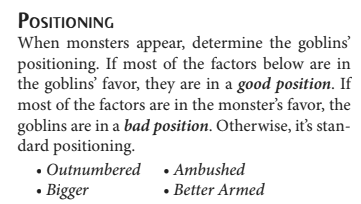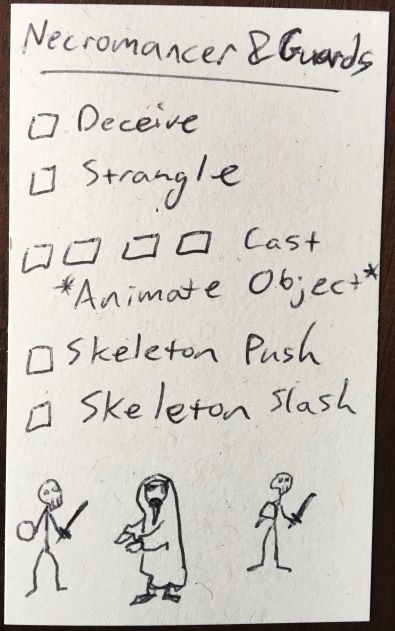Hey Nate,
These are great questions, and I think they highlight some important points for folks coming to Goblinville from other systems. I'm going to try to answer through an example. If you still have questions, let me know.
Four goblins enter a tomb and they are attacked by six skeleton warriors. A skeleton warrior has 3 moves: shamble, push over, and slash.

However, they also have armor:


With Chainmail (2 armor), a group of enemies (+1 armor), and the goblins outnumbered (+1 armor): the skeletons have 4 armor.
At the table, a skeleton stat block might look like this:

(A pack of six skeletons is tough. It's worth noting that a pack of nine skeletons is not necessarily tougher, but we found that these rules made fighting groups of monsters challenging without turning it into a slog. )
The GM frames their approach based on the moves: "The sacrophogi burst open, and a skeletal warrior emerges out of each one. They shamble toward you, blades drawn." Since problems like this target the first goblin in marching order, the GM turns to that player and says: "You see the skeletons' bent and rusted swords still have a jagged edge, what do you do?"
The player says that their goblin attacks the nearest skeleton with their broken bottle. The GM assesses the positioning:

The skeletons are bigger, better armed, and more numerous. The goblins are in a definitely in a bad position.
The GM passes the player their action die and restates the action (you might harm the skeleton), then hands over a danger die and states the danger (you might get knocked to the floor). The goblin is also risking harm (from the sword) so they grab a third die.
The player then resolves the action, danger, and harm. Maybe they are panicked (from the harm roll) and tackled by a skeleton, but they managed to stab one ( the GM crosses out an armor on the skeleton stat block).
If another player describes their goblin helping the first one to their feet, then the GM sets the conditions for that roll: action (you help your ally up and improve your positioning), danger (the tackled goblin is injured), and harm. Note that this puts a goblin at risk who is out of the marching order, but still leaves resolution in the players' hands. I've seen so many players mark a condition for their own goblin to protect an ally.
To address a few of your specific questions:
Monsters don't need a place in the marching order. They present dangers that set the terms of the players' rolls. Since each roll resolves the goblin's action and the danger they face (along with potential harm and twists) the GM doesn't need a turn. That said, they should constantly be putting pressure on the players and asking how they respond.
Positioning can easily go from good to bad in a single action. Maybe the goblins want to attempt something that would be impossible if not for the advantageous position that they're in. The GM can slide the position tracker to 'bad' and let the goblin take their shot. If a player is surprised that an action puts them in bad position, let them reframe what they are attempting. Maybe they can achieve something more modest with less risk. The position tracker helps the players and GM maintain a shared sense of the stakes of a given situation: move it when it makes sense to.
It sounds like you're concerned the player might refuse to have their goblin act (since they face consequences on a failed roll) but I haven't seen this happen in play. If the player says their goblin does nothing, the GM should ask what they hope to accomplish/ what they want out of the situation. You could say: "if you stand still this skeleton is going to run you through with a sword. Is that what you do?" If they say yes, then they mark injured. i'm not saying that you should inflict conditions without a roll, but Goblinville is all about telling players the potential consequences and asking what they do. In practice, if you ask the player what they want to accomplish, then they end up moving the game forward (either with a roll or a good idea).
Mixed units of enemies certainly comes up sometimes. The only change you make is to replace those generic armor slots (that monsters get from being in a group) with specific moves from the other types of monsters present. Here's a necromancer with his skeleton guards:

One thing to note, in your example you ask about "3 clerics, 3 skeletons, 3 zombies, and a necromancer". Those are probably impossible stakes for a group of goblins. I would recommend starting with the adventures from the books, seeing how tough a human or two can be for a goblin, and playing from there.
Happy to answer any other questions that come up, or to tag in some other players on the forum who have experience with running conflicts.

